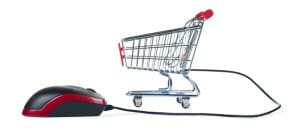Retailers have been struggling to meet the omni-channel demands of their customers. In fact, it’s surprising the number of retailers that still do not offer “buy online, pick up in-store” capabilities. In-store fulfillment of online orders poses a few logistical challenges for retailers, including where will the online orders be picked? Retailers have a few options – associates can pick from the front of the store or the back of the store during store hours. Depending on pick-up timeframes, retailers can also dedicate after hours to in-store pick-up orders. As the online channel has grown from a small complimentary channel into an increasingly larger portion of overall sales and revenue, this seems like a logical step for retailers to take.
One segment of the retail market that has not been in the mix for “buy online, pick up in-store” until recently is the grocery industry. However, with companies like Peapod leading the charge, grocery stores have been a player in the e-commerce space. Founded in 1989 as a small family run shopping and delivery service, Peapod was acquired by Royal Ahold. Working in partnership with Ahold USA, Peapod enables home delivery of groceries through a variety of regional chains, such as Stop & Shop and Giant Food Stores. As this model has proven successful, large companies such as Walmart and Amazon have joined the home grocery delivery business. In Canada, however, the model is simply not efficient enough. The problem largely lies in the fact that Canada is a sparsely populated country. It is simply not efficient to deliver groceries to individual customer’s homes. But that doesn’t mean that Canadian grocery stores are walking away from the online channel. Instead, they are marching forward with a proven model of traditional retail – buy online, pick up in-store.
Drawing from the experience and success of companies like Best Buy Canada and London Drugs, Canadian grocery store chain Loblaw announced that it would test the capabilities at a few select stores. With their recent acquisition of Shopper’s Drug Mart Corp, Loblaw adds over 1,000 additional pick-up points if the tests go well and full-scale deployment takes place.
From a pure customer experience standpoint, this could revolutionize the grocery industry. First and foremost, it streamlines the grocery shopping process for customers. In today’s hyper-busy world, people want convenience and speed when it comes to shopping. Allowing the customer to make all their decisions ahead of time and simply swing by the store on their way home from work makes it easier for busy, working adults to buy their groceries. Mobile capabilities will enable customers to shop online through smart phones and tablets. For those taking public transportation, imagine the ease of purchasing your groceries on your phone on the way to the store. All you have to do is pick them up when you get there.
From an inventory standpoint, the challenge will be to align online and traditional in-store inventory and demand levels. Grocery stores will need to evaluate whether they start with a pre-defined number of SKU’s which will be available for the buy online, pick up in-store program or whether to open up the full catalog. Each has its own benefits and drawbacks. If grocers start with a pre-defined number of SKU’s, they can bring in additional safety stocks to ensure that the product will be available for both online and in-store customers. However, if the customer is unable to fulfill their entire order through the online channel, they will have to come into the store to continue shopping which will eliminate the biggest convenience. Conversely, if grocers open up the whole catalog, they will enable customers to fulfill their entire order all at once. However, the store can only hold a set amount of merchandise. Attempting to balance supply and demand for both online and offline customers can lead to customer dissatisfaction if the item is out of stock.
Of course not all customers will embrace the new model. There are shoppers out there who are very specific about the products they buy and will not want to let go of that control. Additionally, customers who are not interested in using the internet as a shopping vehicle will not be interested. But this move is about appealing to a younger, more mobile generation of shoppers. And while it may just in the beginning stages of deployment, if the customer can get the groceries they need, they will come back.


















